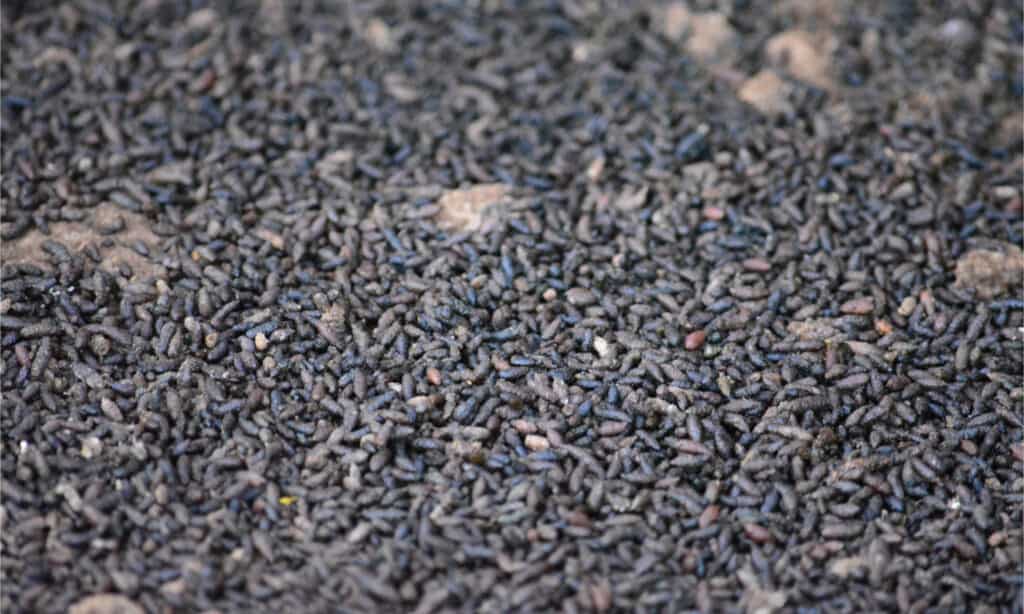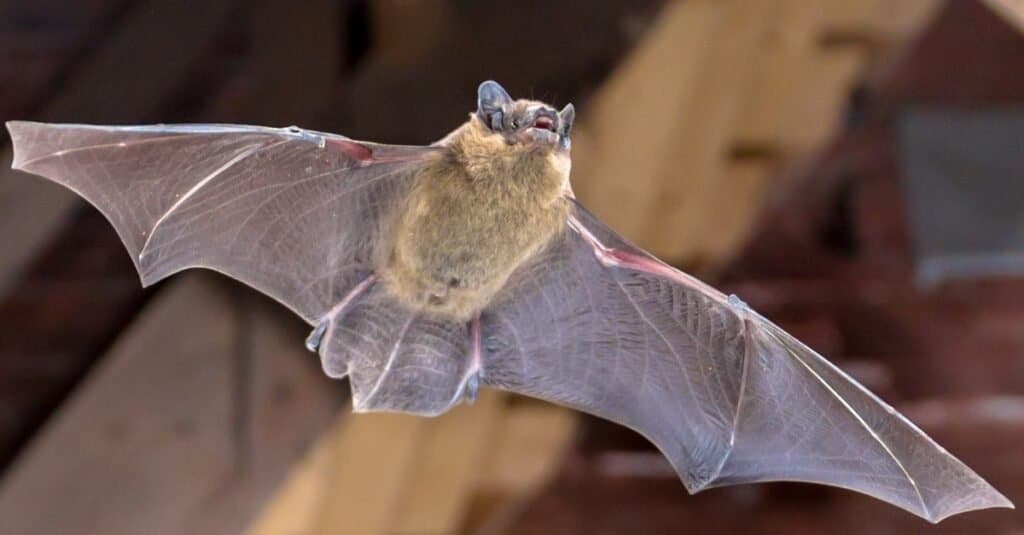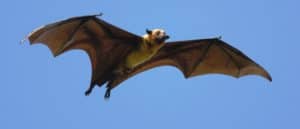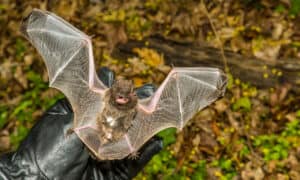The idea of bats is somehow terrifying, especially if you picture a bouquet of them hanging upside down cave ceilings and then chaotically flying all around you – just like how most movies portray bats. But in reality, bats are not as dangerous as they are depicted, and as a matter of fact, they are cute too!
Yet, perhaps one mind-blowing thing you did not know about bats is that they benefit the environment, especially gardeners. So what about bats is so important that they help gardens flourish? If you are thinking about poop right now, you’re guessing it right. Bat poop or bat guano is a significant ingredient in keeping a garden healthy, and in this article, we will explore more about that. So, what does bat poop look like, and what is it used for?
What Does Bat Guano Look Like?

There is a noticeable ammonia smell in bat guano.
©LifeLoveLiberty/Shutterstock.com
What does bat poop look like? Guano is the term for bats’ small, dark-colored droppings left behind. When touched, the elongated pellets crumble and turn to dust. They resemble rugby balls since they are typically oval and have rounded ends. Some poop have tiny sharp ends and frequently have iridescent shine. Bat guano may consist of one, two, or three sections.
Since bats mainly eat fruits and insects, only the inedible components of their insect diet are found in their excretions. Their excrement has a crumbly texture due to this substance, making it possible to distinguish it from mouse excrement, which has a similar appearance but dries to a very hard consistency.
Does Bat Guano Smell?
The simple answer is yes. In attics, wall cavities, and other voids, bat excrement decomposes and releases an offensive odor. This strong, musty, and bitter smell can often be found in building housings or long-term colonies. Animals who perish in remote regions also release a similar odor.
There is a noticeable ammonia smell in bat guano as well. Some homeowners may never see the guano, but they can still smell it. Once there is an infestation, ammonia from bat pee gives off a pungent odor that is eerily similar to that of a cat litter box that has been soaked in urine.
What is Bat Guano Used For?
Surprisingly, bat guano makes some of the world’s most effective fertilizers. You have heard about bird or chicken manure being converted as fertilizers, but have you ever heard about bat guano?
Organic bat guano can even be purchased in stores or online as fertilizers. The amassed waste of seabirds and bats is known as guano. The term is most frequently used to refer to manure used to fertilize gardens.
Using bat guano, or feces, to enhance soil dates back many years. Only fruit- and insect-feeding species provide it. Bat guano works quickly, emits little smell and can be incorporated into the soil before planting or while the plant is actively growing.
Bat excrement helps plants produce strong stems, stimulates flowering, fosters root growth, and encourages green, rapid growth for lawns. Additionally, it makes dense soils lighter and helps hold together loose soils. It has been discovered that the microbes in bat excrement are capable of bioremediation, suggesting that bat guano can help remove toxins from soils.
Can Bat Poop Be Made as Coffee?

Bat poop cannot be made as coffee.
©Rudmer Zwerver/Shutterstock.com
Believe it or not, some coffee beans are made from animal excrement. This idea might not be new to you as you have heard these myths before. However, bat poop does not make coffee. But there is an important relationship between coffee and bats called the bat spit coffee.
Do you know about Kopi Luwak coffee? Contrary to popular belief, the most expensive coffee in the world is prepared from beans that the civet, a cat-like mammal native to Southeast Asia and sub-Saharan Africa, partly digests and then excretes. Unlike civet cats that consume and digest coffee cherries, bats tend to eat them but can’t swallow the coffee cherries because they are too little to do so. It is hypothesized that their digestive secretions and ambient air would react to create a particularly smooth flavor. It’s a healthy way to process coffee!
Is Bat Poop Used in Make-up Products?
The simple answer is no. Bat guano may be good fertilizer, but it has nothing to do with make-up or personal care products. The entire “bat poop in mascara” rumor is an elaborate urban legend.
Guanine, which happens to be plentiful in bat feces, has been added to numerous cosmetics to give them a sparkly, iridescent appearance. In actuality, “guano” is the root word of “guanine.” However, beauty businesses do not use bat guano in their products. The FDA mandates that guanine exclusively comes from fish scales when used in cosmetics.
Is Bat Poop Harmful?
Guano is frequently utilized as fertilizer because of its high nitrogen and phosphorus content, but it can be hazardous when it builds up inside the home. Although bat guano benefits the environment, you should keep it out of your house since it risks your health.
If disturbed, bat guano can release infectious spores that can cause Histoplasmosis. The histoplasmosis fungus, which causes serious respiratory issues in people, grows in the nutrient-rich bat droppings. Fever, coughing, and weariness are some of its symptoms. While many people with Histoplasmosis recover without treatment, the infection can become severe in some people, such as those with compromised immune systems.
What Do Bats Eat?

Microbats that fly around and consume insects include the little brown bat and the northern long-eared bat. They consume beetles, crickets, chinch bugs, moths, and mosquitoes. On the other hand, fruit is the main source of nutrition for megabats like the fruit bat and flying foxes. They might consume papaya, guava, figs, or bananas.
Some megabats consume nectar and pollen as well. It has been said that vampire bats only consume animal blood for their daily needs, and the only source of nutrition is blood. They also have a very low fat reserve, which means they can’t go longer than a few days without eating without dying.
How Big Is the Guano Market?
The bat and bird guano market is huge: From half a billion in 2020 to projected global sales of 0.83 billion in 2028! Guano provides a wide range of benefits as a fertilizer because it is highly rich in phosphate, potassium, and nitrogen.
One of these benefits is that it helps control various crop-related diseases. Similarly, guano combats crop fungal and bacterial infections that are rapidly spreading as a result of changing climatic conditions.
The demand for guano is increasing with the demand for new and mechanized techniques for agriculture, especially in the developing countries. As technology in farming equipment and industrial competitiveness increase, so does the demand for guano to raise the best crops and produce greater amounts of food for a growing world population.
The photo featured at the top of this post is © Rudmer Zwerver/Shutterstock.com
Thank you for reading! Have some feedback for us? Contact the AZ Animals editorial team.






